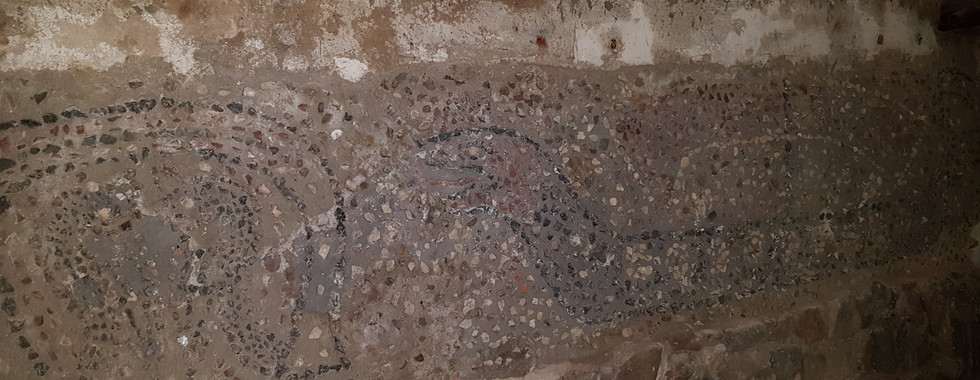Mummys, Mystics, and a Prussian Baron
- Kieran Houston

- Sep 26, 2018
- 6 min read
Updated: Nov 24, 2019
In the north of Poland, just a few kilometres from the Russian border by a town called Rapa, there is a pyramid. A pyramid sharing the exact same dimensions as those found in Giza and used for the exact same purpose. As a burial site. This pyramid was built in 1811 by Friedrich Heinrich Fahrenheit, an important and wealthy Prussian nobleman.

Friedrich was a world traveller, art collector, land owner and most importantly, fascinated by stories of the wonder of the Egyptian pyramids, and so when he had these pyramids built for himself and his family to one day be laid to rest in them, there is no doubt that there was some mystical reason for doing so. And there was. Friedrich truly believed. He believed in reincarnation, in life after death. He believed so far to the point he had his own family, starting with his 3 year old daughter, mummified before being placed into the tomb. To further reinforce his ideologies, the structure itself was built on the intersection of three ley lines which are apparent alignments to religious structures or landmarks of significant importance. Clearly, Friedrich knew what he was doing when he built this structure, however I have no doubt many others thought he was slightly crazy. The pyramid held strong, Friedrich and his family were mummified and laid to rest in peace. That is until the end of the second world war when the soviet army blasted their way through the pyramid in search of treasure, decapitated the corpses of Friedrich and his family and left them bare for the world to see. Which the world did see for many years to come. But not in the way they expected. Although these ley lines are commonly thought of as myth, there are peculiar features about this grave site which confuse every visitor, besides those who make their dealings with mystics and witchcraft and other... magical terms. Around the pyramid, in the swampy marshlands, there are a few missing regulars. Mosquitoes, other bugs, werewolves etc. It is believed the power of these ley lines, either thought to be an energy force or the earths magnetic fields, keeps such critters away. But besides simply being one giant pyramid shaped mosquito repellent, it was also discovered that the bodies of Friedrich and his family almost refused to decompose. Although left to the open elements by the soviets, specifically from the neck down, the bodies of this 19th century aristocrat and his troupe were holding it together. Of course, after long being a tourist destination for a quick decapitated mummy selfie before feeling nauseous from the mystical presence, the pyramid was closed to the public in 2008. The bodies sealed in their tombs and a lock slammed on the sole entrance.
After visiting the pyramid myself, and finding it surrounded by construction works and a single civil worker sipping a coffee and reading the daily news, I discovered there wasn't much to discover here. If I wanted to know more, I had to go elsewhere. So I did. Alongside my companion who is somewhat of a local treasure hunter, we set off to the place that would hold the most answers, Friedrich Heinrich Fahrenheit's abandoned manor.

On the way I was welcomed with beautifully translated stories of the area. The numerous single German soldier graves dotted in between farmlands, the bunkers hidden in the trees from second world war battle sites, and the thousands of treasures our friend had found in the area, from single bullets to helmets to entire bodies draped in worn clothing grasping a Karabin rifle. It's fair to say I was undoubtedly intrigued. As we came closer to the estate, I found out the entire region around the estate was owned by Friedrich. He hired all of the workers on the farms and owned every inch of land. Why was it so important to him? He must have had a reason for choosing such a place, considering his obsession with the mystical side of life.
The manor was extraordinary. It was desolate, consumed by nature and left in ruins and yet thankfully, still yet to be covered by graffiti, thanks to the incredibly hidden area in which it has secured itself. Surrounded by trees, overgrown from nature, it has almost been completely retaken by the earth. Understandably, all of the beautiful architecture, tiles, statues, anything with value, had been taken from this place. There were marble plinths lacking a host. Bare walls with tool scratches and broken tiles. It was completely abandoned and quite frankly, very very sad.

As with every abandoned building, I couldn't wait to explore every room. The ground floor held nothing but the ruins of the roof that had caved through and landed below, it was mostly inaccessible, so we ventured further down into the floors below. We were underground yet small windows at ground level allowed a bit of light to enter. I had never seen anything like this before, in the middle of the day we needed torches to see, as we stumbled across the rubble. The purpose to build such a complex plan of easily 15 rooms beneath their house, some with clear purpose such as a wash house still bearing some rusted metal appliances and white tiled walls, still remained a mystery to me. Every room was completely empty and I was starting to lose hope of finding anything. As we meandered our way through the last of the rooms, I noticed a shimmer on the wall and shone my torch onto it. The wall came to life with colour, with beautiful stones protruding from the wall. I stepped back and started to figure out the shapes. On each side of this long stretch of wall were what appeared to be viking dragonships, viking longships with a carved dragon head at the front to fend away evil spirits. The ships faced inwards towards a centrepiece, a strange image and one I could not make sense of. With the look of perhaps two tail-ends of ships meeting in the middle surrounded by some form of wave. I admired the beautiful stonework, the shields along the sides of the ships. The eyes of the dragon and the split tongue.
I turned and crossed the room to be welcomed by a much clearer mosaic. In the same style, with protruding colourful rocks, each of the twelve star signs embedded in the wall in large circles, perfectly placed. To the right of these on the joining wall, a mosaic of the sun. I stood with this immense feeling. Looking at these symbols and thinking why? How do they connect with the whole Egyptian mummification side of Friedrichs life? After Alexander the Great's conquest of Egypt, Hellenistic astrology was implemented into life throughout Egypt as opposed to the belief of the Egyptian gods representing periods of the year. Friedrich was clearly a very spiritual and intellectual man and so this must have held some meaning to him. It felt almost like some kind of puzzle. Behind the correct star sign is all the treasure you could imagine, choose wisely. The soviets certainly found no treasure in his grave, contradictory to how the Egyptians did it. Yet after taking photos and spending a minute to pretend I was Indiana Jones trying to figure out this wild astrological game, we decided to turn back and head out of the estate. Taking the long route back to the car, we took in the sheer size of this lost legacy. The estate, the land, the buildings, and the wonderful scenery. Now claimed by nature, which I certainly had no issues with.
Our last stop took us to another tomb nearby from around the same time as Friedrich had lived. This cube shaped stone tomb, built in 1860, contains an engraved cross with the inscription 'Marta Steinert (1863-1891) and once again, two mummified bodies with decapitated heads. As with the Rapa Pyramid, this tomb was looted during the second world war, leaving the two grave posts outside the tomb partially destroyed however one of these posts still stands today, bearing a heart and the date 1863. How this may tie in with Friedrich is still a mystery, but alone, it is a beautiful memorial to this local family and deserving of its peace.

The peculiar tale of Friedrich Heinrich Fahrenheit is certainly still open for discovery. Whether he was just a wealthy man obsessed with finding life after death or just a regular land baron with a fancy grave is unknown. But one thing's for certain, he was pretty damn devoted to the mystical side of life.















Comentarios